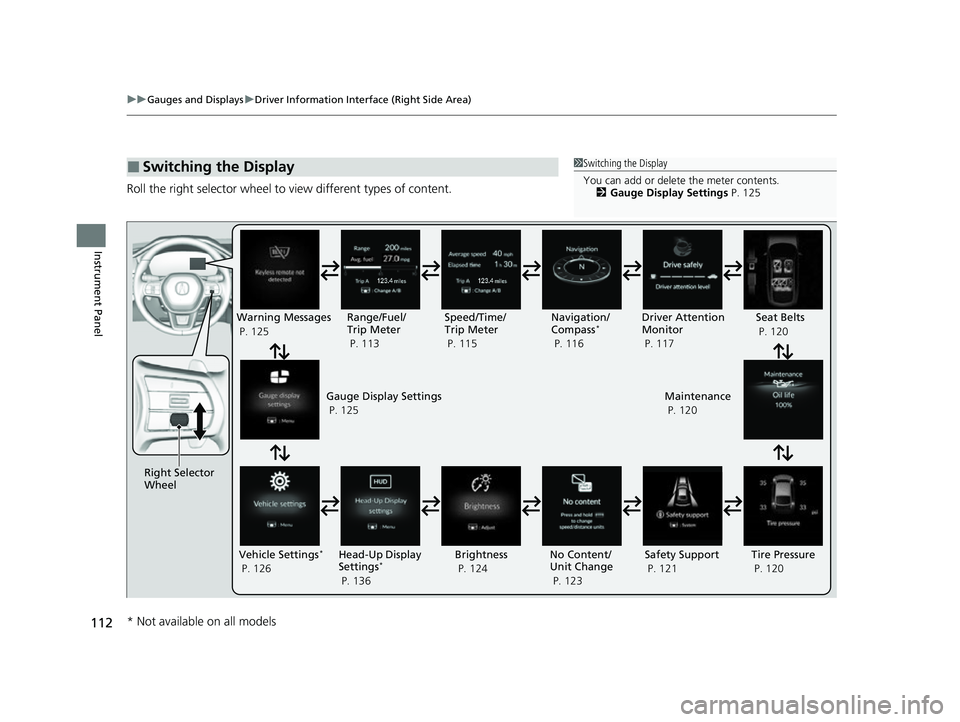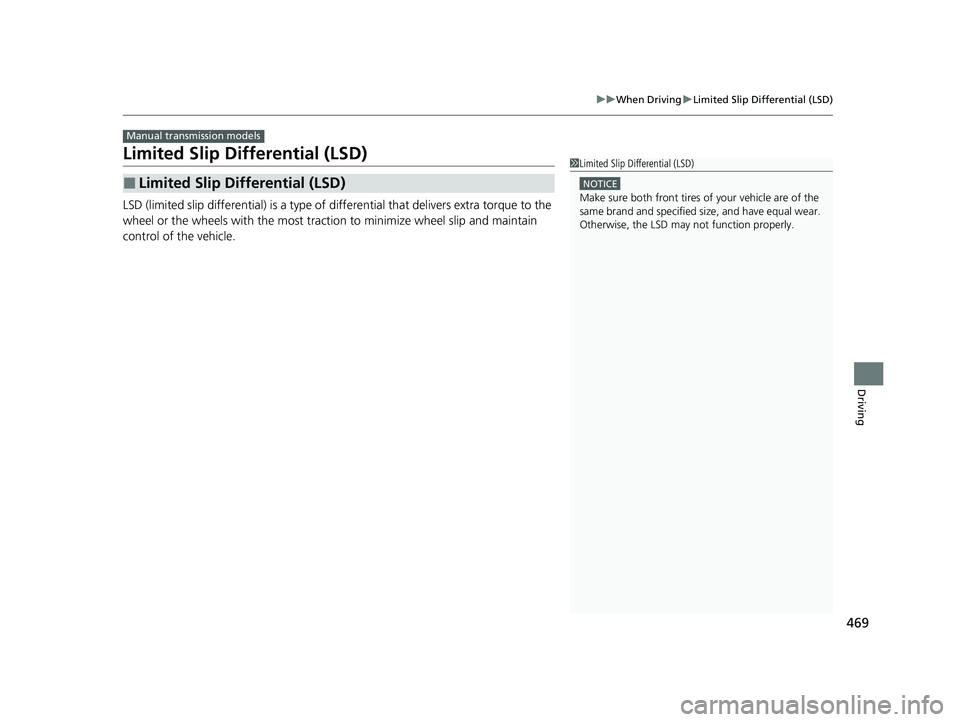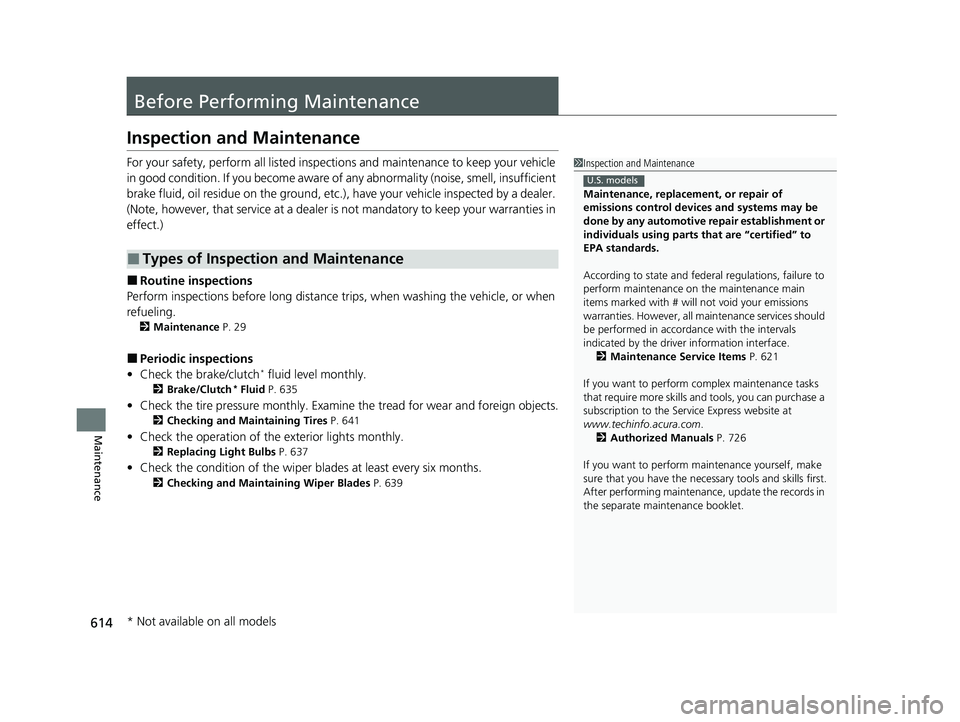tire type ACURA INTEGRA 2023 Owners Manual
[x] Cancel search | Manufacturer: ACURA, Model Year: 2023, Model line: INTEGRA, Model: ACURA INTEGRA 2023Pages: 740, PDF Size: 22.94 MB
Page 114 of 740

112
uuGauges and Displays uDriver Information Interface (Right Side Area)
Instrument Panel
Roll the right selector wheel to view different types of content.
Ō¢ĀSwitching the Display1Switching the Display
You can add or delete the meter contents.
2 Gauge Display Settings P. 125
Right Selector
WheelWarning Messages
P. 125
Range/Fuel/
Trip Meter
P. 113
No Content/
Unit Change
P. 123Driver Attention
Monitor
P. 117
Navigation/
Compass
*
P. 116
Speed/Time/
Trip Meter
P. 115
Gauge Display Settings
P. 125 Maintenance
P. 120
Safety Support
P. 121 Seat Belts
P. 120
Vehicle Settings
*
P. 126 Head-Up Display
Settings*
P. 136 Brightness
P. 124
Tire Pressure
P. 120
* Not available on all models
23 ACURA INTEGRA-313S56000_03.book 112 ŃāÜŃā╝ŃéĖ ’╝Æ’╝É’╝Æ’╝ÆÕ╣┤’╝ōµ£ł’╝æ’╝śµŚźŃĆĆķćæµø£µŚźŃĆĆÕŹłÕēŹ’╝æ’╝æµÖé’╝ö’╝ŚÕłå
Page 468 of 740

466
uuWhen Driving uVehicle Stability AssistTM (VSA ®), aka Electronic Stability Control (ESC), System
Driving
Vehicle Stability AssistTM (VSA ®), aka Electronic
Stability Control (ESC), System
VSA ® helps stabilize the vehicle during cornering if the vehicle turns more or less
than what was intended. It also assists in maintaining traction on slippery surfaces.
It does so by regulating engine output and selectively applying the brakes.
When VSA® activates, you may notice that the
engine does not respond to the accelerator.
You may also notice some noise from the
hydraulic brake system. You will also see the
indicator blink.
Ō¢ĀVSA ┬« Operation
1 Vehicle Stability AssistTM (VSA ®), aka Electronic Stability Control
(ESC), System
The VSA ® may not function properl y if tire type and
size are mixed. Make sure to use the same size and
type of tire, and the air pressures as specified.
When the VSA ® system indicator comes on and stays
on while driving, there may be a problem with the
system. While this may not interfere with normal
driving, have your vehi cle checked by a dealer
immediately.
The Vehicle Stability Assist
TM (VSA ®) system, Adaptive
Cruise Control (ACC)*, Adaptive Cruise Control
(ACC) with Low Speed Follow* and safety support
indicators may come on in amber along with a
message in the gauge when you set the power mode
to ON after reconnecting the battery.
Drive a short distance at more than 12 mph (20 km/h).
Each indicator should go off. If any do not, have your
vehicle checked by a dealer.
VSA ® cannot enhance stability in all driving situations
and does not control the entire braking system. You
still need to drive and corner at speeds appropriate
for the conditions and always leave a sufficient
margin of safety.
The main function of the VSA ® system is generally
known as Electronic Stab ility Control (ESC). The
system also includes a traction control function.
VSA® System
Indicator
* Not available on all models
23 ACURA INTEGRA-313S56000_03.book 466 ŃāÜŃā╝ŃéĖ ’╝Æ’╝É’╝Æ’╝ÆÕ╣┤’╝ōµ£ł’╝æ’╝śµŚźŃĆĆķćæµø£µŚźŃĆĆÕŹłÕēŹ’╝æ’╝æµÖé’╝ö’╝ŚÕłå
Page 471 of 740

469
uuWhen Driving uLimited Slip Differential (LSD)
Driving
Limited Slip Differential (LSD)
LSD (limited slip differential) is a type of differential that delivers extra torque to the
wheel or the wheels with the most tracti on to minimize wheel slip and maintain
control of the vehicle.
Ō¢ĀLimited Slip Differential (LSD)
Manual transmission models
1 Limited Slip Differential (LSD)
NOTICE
Make sure both front tires of your vehicle are of the
same brand and specified si ze, and have equal wear.
Otherwise, the LSD may not function properly.
23 ACURA INTEGRA-313S56000_03.book 469 ŃāÜŃā╝ŃéĖ ’╝Æ’╝É’╝Æ’╝ÆÕ╣┤’╝ōµ£ł’╝æ’╝śµŚźŃĆĆķćæµø£µŚźŃĆĆÕŹłÕēŹ’╝æ’╝æµÖé’╝ö’╝ŚÕłå
Page 490 of 740

uuAcuraWatchTMuCollision Mitigation Braking SystemTM (CMBSTM)
488
Driving
Ō¢ĀExamples of limitations on the correc t detection of the camera due to the
condition of the vehicle ahead of you, oncoming vehicles, pedestrians, or
moving bicycles
ŌĆó The distance between your vehicle an d the vehicle ahead of you, oncoming
vehicle, pedestrian, or moving bicycle ahead of you is too short.
ŌĆó The vehicle ahead of you, oncoming vehicle, pedestrian, or moving bicycle
suddenly cuts in front of or jumps out in front of you.
ŌĆó The bicycle is stopped.
ŌĆó The oncoming vehicle or vehicle ahead of you is sideways.
ŌĆó When the vehicle ahead of you, oncoming vehicle, pedestrian, or moving bicycle
blends in with the background, preventing the system from recognizing them.
ŌĆó When several pedestrians or bicycles are moving ahead of you in a group.
ŌĆó When a pedestrian or moving bicycle crosses the road too quickly.
ŌĆó A pedestrian or moving bicycle approaches from the opposite direction.
ŌĆó The headlights of the vehicle ahead of you or oncoming vehicle are lit on one side
or not lit on either side in a dark place.
ŌĆó When part of a pedestrian (heads, limbs, etc.) is hidden by load.
ŌĆó When a pedestrian is bent over or squatt ing, when their hands are raised, or they
are running.
ŌĆó When the pedestrian is shorter than about 3.3 feet (1 meter) or taller than about
6.6 feet (2 meters) in height.
ŌĆó When the pedestrian is pu shing a stroller or bicycle.1Collision Mitigation Braking SystemTM (CMBSTM)
Make sure that all the tires are of the same specified
size, type and brand, and that they are evenly worn.
If you use tires of different sizes, types, brands, or
degree of wear, the syst em may not work properly.
Do not modify the suspensi on. Altering the height of
the vehicle may prevent the system from working
properly.
23 ACURA INTEGRA-313S56000_03.book 488 ŃāÜŃā╝ŃéĖ ’╝Æ’╝É’╝Æ’╝ÆÕ╣┤’╝ōµ£ł’╝æ’╝śµŚźŃĆĆķćæµø£µŚźŃĆĆÕŹłÕēŹ’╝æ’╝æµÖé’╝ö’╝ŚÕłå
Page 596 of 740

594
uuBraking uAnti-lock Brake System (ABS)
Driving
Anti-lock Brake System (ABS)
Helps prevent the wheels from locking up, an d helps you retain steering control by
pumping the brakes rapidly, much faster than you can.
The electronic brake distribution (EBD) system, which is part of the ABS, also
balances the front-to-rear braking distri bution according to vehicle loading.
You should never pump the brake pedal. Let the ABS work for you by always
keeping firm, steady pressure on the brake pe dal. This is sometimes referred to as
ŌĆ£stomp and steer.ŌĆØ
Ō¢ĀABS operation
The brake pedal may pulsate slightly when the ABS is working. Depress the brake
pedal and keep holding the pedal firmly do wn. On dry pavement, you will need to
press on the brake pedal very hard before the ABS activates. However, you may feel
the ABS activate immediately if yo u are trying to stop on snow or ice.
ABS may activate when you depress the brake pedal when driving on:
ŌĆó Wet or snow covered roads.
ŌĆó Roads paved with stone.
ŌĆó Roads with uneven surfaces, such as potholes, cracks, manholes, etc.
When the vehicle speed goes unde r 6 mph (10 km/h), the ABS stops.
Ō¢ĀABS1Anti-lock Brake System (ABS)
NOTICE
The ABS may not function correctly if you use a tire of
the incorrect size or type.
If the ABS indicator comes on while driving, there
may be a problem with the system.
While normal braking will not be affected, there is a
possibility that the ABS wi ll not be operating. Have
your vehicle checked by a dealer immediately.
The ABS is not designed for the purpose of reducing
the time or distance it takes for a vehicle to stop: It is
designed to limit brake lo ckup which can lead to
skidding and loss of steering control.
In the following cases, yo ur vehicle may need more
distance to stop than a vehicle without the ABS:
ŌĆóYou are driving on rough or uneven road surfaces,
such as gravel or snow.
ŌĆóThe tires are equipped with tire chains.
The following may be observed with the ABS system:
ŌĆóMotor sounds coming from the engine
compartment when the brakes are applied, or
when system checks are being performed after the
engine has been started and while the vehicle
accelerates.
ŌĆóBrake pedal and/or the vehicle body vibration when
ABS activates.
These vibrations and sou nds are normal to ABS
systems and are no cause for concern.
23 ACURA INTEGRA-313S56000_03.book 594 ŃāÜŃā╝ŃéĖ ’╝Æ’╝É’╝Æ’╝ÆÕ╣┤’╝ōµ£ł’╝æ’╝śµŚźŃĆĆķćæµø£µŚźŃĆĆÕŹłÕēŹ’╝æ’╝æµÖé’╝ö’╝ŚÕłå
Page 616 of 740

614
Maintenance
Before Performing Maintenance
Inspection and Maintenance
For your safety, perform all listed inspections and maintenance to keep your vehicle
in good condition. If you become aware of an y abnormality (noise, smell, insufficient
brake fluid, oil residue on the ground, etc.), have your vehicle inspected by a dealer.
(Note, however, that service at a dealer is not mandatory to keep your warranties in
effect.)
Ō¢ĀRoutine inspections
Perform inspections before long distance trips, when washing the vehicle, or when
refueling.
2 Maintenance P. 29
Ō¢ĀPeriodic inspections
ŌĆó Check the brake/clutch* fluid level monthly.
2 Brake/Clutch* Fluid P. 635
ŌĆóCheck the tire pressure monthly. Examin e the tread for wear and foreign objects.
2Checking and Maintaining Tires P. 641
ŌĆóCheck the operation of the exterior lights monthly.
2 Replacing Light Bulbs P. 637
ŌĆóCheck the condition of the wiper bl ades at least every six months.
2Checking and Maintaining Wiper Blades P. 639
Ō¢ĀTypes of Inspection and Maintenance
1Inspection and Maintenance
Maintenance, replacement, or repair of
emissions control devices and systems may be
done by any automotive repair establishment or
individuals using parts that are ŌĆ£certifiedŌĆØ to
EPA standards.
According to state and fede ral regulations, failure to
perform maintenance on the maintenance main
items marked with # will not void your emissions
warranties. However, all ma intenance services should
be performed in accordan ce with the intervals
indicated by the driver information interface.
2 Maintenance Service Items P. 621
If you want to perform complex maintenance tasks
that require more skills a nd tools, you can purchase a
subscription to the Service Express website at
www.techinfo.acura.com .
2 Authorized Manuals P. 726
If you want to perform ma intenance yourself, make
sure that you have the necessary tools and skills first.
After performing maintenanc e, update the records in
the separate maintenance booklet.
U.S. models
* Not available on all models
23 ACURA INTEGRA-313S56000_03.book 614 ŃāÜŃā╝ŃéĖ ’╝Æ’╝É’╝Æ’╝ÆÕ╣┤’╝ōµ£ł’╝æ’╝śµŚźŃĆĆķćæµø£µŚźŃĆĆÕŹłÕēŹ’╝æ’╝æµÖé’╝ö’╝ŚÕłå
Page 643 of 740

641
Maintenance
Checking and Maintaining Tires
Checking Tires
To safely operate your vehicle, your tires must be of the proper type and size, in
good condition with adequate tread, and properly inflated.
Ō¢ĀInflation guidelines
Properly inflated tires provide the best combination of handling, tread life, and
comfort. Refer to the driverŌĆÖs doorjamb labe l or specifications page for the specified
pressure.
Underinflated tires wear unev enly, adversely affect handling and fuel economy, and
are more likely to fail from overheating.
Overinflated tires make your vehicle ride ha rshly, are more prone to road hazards,
and wear unevenly.
Every day before you drive, look at each of the tires. If one looks lower than the
others, check the pressure with a tire gauge.
At least once a month or before long trips , use a gauge to measure the pressure in
all tires, including the spare
*. Even tires in good condition can lose 1-2 psi (10-20
kPa, 0.1-0.2 kgf/cm2) per month.
Ō¢ĀInspection guidelines
Every time you check inflation, also examine the tires and valve stems. Look for:
ŌĆó Bumps or bulges on the side or in the tr ead. Replace the tire if you find any cuts,
splits, or cracks in the side of the tire . Replace it if you see fabric or cord.
ŌĆó Remove any foreign objects and inspect for air leaks.
ŌĆó Uneven tread wear. Have a deal er check the wheel alignment.
ŌĆó Excessive tread wear.
2 Wear Indicators P. 646
ŌĆóCracks or other damage around valve stem.
1Checking Tires
Measure the air pressure when tires are cold. This
means the vehicle has been parked for at least three
hours, or driven less than 1 mile (1.6 km). If
necessary, add or releas e air until the specified
pressure is reached.
If checked when hot, tire pressure can be as much as
4ŌĆō6 psi (30ŌĆō40 kPa, 0.3ŌĆō0.4 kgf/cm
2) higher than if
checked when cold.
Have a dealer check the tires if you feel a consistent
vibration while driving. Ne w tires and any that have
been removed and reinst alled should be properly
balanced.
3WARNING
Using tires that are excessively worn or
improperly inflated can cause a crash in
which you can be seriously hurt or killed.
Follow all instruction s in this ownerŌĆÖs
manual regarding tire inflation and
maintenance.
* Not available on all models
23 ACURA INTEGRA-313S56000_03.book 641 ŃāÜŃā╝ŃéĖ ’╝Æ’╝É’╝Æ’╝ÆÕ╣┤’╝ōµ£ł’╝æ’╝śµŚźŃĆĆķćæµø£µŚźŃĆĆÕŹłÕēŹ’╝æ’╝æµÖé’╝ö’╝ŚÕłå
Page 644 of 740

642
uuChecking and Maintaining Tires uTire and Loading Information Label
Maintenance
Tire and Loading Information Label
The label attached to the driverŌĆÖs doorj amb provides necessary tire and loading
information.
Tire Labeling
The tires that came on your vehicle have a
number of markings. Those you should be
aware of are described as shown.
Whenever tires are replaced, they should be replaced with tires of the same size.
1 Tire and Loading Information Label
The tire and loading informat ion label attached to the
driverŌĆÖs doorjamb contains:
aThe number of people your vehicle can carry.bThe total weight your vehicle can carry. Do not
exceed this weight.
cThe original tire sizes for front, rear, and spare.dThe proper cold tire pressure for front, rear, and
spare.
Label
Example
Example Tire Size
Tire
Identification
Number (TIN)
Maximum
Tire Load
Maximum
Tire Pressure
Tire Size
Ō¢ĀTire Sizes
1 Tire Sizes
Following is an example of tire size with an
explanation of what each component means.
P205/55 R16 89H
P: Vehicle type (P indi cates passenger vehicle).
205: Tire width in millimeters.
55: Aspect ratio (the tireŌĆÖs section height as a
percentage of its width).
R: Tire construction code (R indicates radial).
16: Rim diameter in inches.
89: Load index (a numerical code associated with the
maximum load the tire can carry).
H: Speed symbol (an alphabe tical code indicating the
maximum speed rating).
23 ACURA INTEGRA-313S56000_03.book 642 ŃāÜŃā╝ŃéĖ ’╝Æ’╝É’╝Æ’╝ÆÕ╣┤’╝ōµ£ł’╝æ’╝śµŚźŃĆĆķćæµø£µŚźŃĆĆÕŹłÕēŹ’╝æ’╝æµÖé’╝ö’╝ŚÕłå
Page 645 of 740

643
uuChecking and Maintaining Tires uTire Labeling
Maintenance
The tire identification number (TIN) is a group of numbers and letters that look like
the example in the side column. TIN is located on the sidewall of the tire.
Cold Tire Pressure ŌĆō The tire air pressure when the vehicle has been parked for at
least three hours or driven less than 1 mile (1.6 km).
Load Rating ŌĆō Means the maximum load that a ti re is rated to carry for a given
inflation pressure.
Maximum Inflation Pressure ŌĆō The maximum tire air pressure that the tire can
hold.
Maximum Load Rating ŌĆō Means the load rating for a tire at the maximum
permissible inflation pr essure for that tire.
Recommended Inflation Pressure ŌĆō The cold tire inflation pressure recommended
by the manufacturer.
Treadwear Indicators (TWI) ŌĆō Means the projections within the principal grooves
designed to give a visual indication of the degrees of wear of the tread.
Ō¢ĀTire Identification Number (TIN)
Ō¢ĀGlossary of Tire Terminology
1Tire Identification Number (TIN)
DOT B97R FW6X 2209
DOT: This indicates that the tire meets all
requirements of the U.S. Department of
Transportation.
B97R: Manufacturer's identification mark.
FW6X: Tire type code.
22 09: Date of manufacture.
Year
Week
23 ACURA INTEGRA-313S56000_03.book 643 ŃāÜŃā╝ŃéĖ ’╝Æ’╝É’╝Æ’╝ÆÕ╣┤’╝ōµ£ł’╝æ’╝śµŚźŃĆĆķćæµø£µŚźŃĆĆÕŹłÕēŹ’╝æ’╝æµÖé’╝ö’╝ŚÕłå
Page 649 of 740

647
uuChecking and Maintaining Tires uTire and Wheel Replacement
Maintenance
Tire and Wheel Replacement
Replace your tires with radials of the sa me size, load range, speed rating, and
maximum cold tire pressure rating (as shown on the tireŌĆÖs sidewall). Using tires of a
different size or construction can cause ce rtain vehicle systems such as the ABS and
Vehicle Stability Assist
TM (VSA ®) system to work incorrectly.
It is best to replace all four tires at the same time. If that isnŌĆÖt possible, replace the
front or rear tires in pairs.
Whenever you have a tire replaced or reset, make sure that the rubber valve stem is
replaced and that the TPMS sensor is trans ferred from the old valve stem to the new
one.
If you replace a wheel, make sure that the wheelŌĆÖs specifications match those of the
original wheels.
1 Tire and Wheel Replacement
3WARNING
Installing improper tires on your vehicle can
affect handling and stability. This can cause
a crash in which you can be seriously hurt or
killed.
Always use the size and type of tires
recommended in this ownerŌĆÖs manual.
23 ACURA INTEGRA-313S56000_03.book 647 ŃāÜŃā╝ŃéĖ ’╝Æ’╝É’╝Æ’╝ÆÕ╣┤’╝ōµ£ł’╝æ’╝śµŚźŃĆĆķćæµø£µŚźŃĆĆÕŹłÕēŹ’╝æ’╝æµÖé’╝ö’╝ŚÕłå